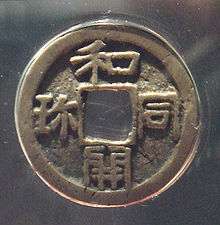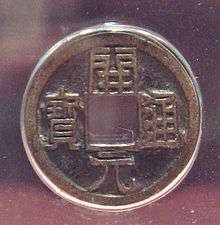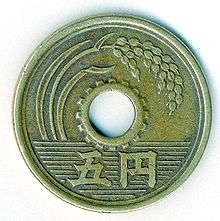Wadōkaichin



Wadōkaichin (和同開珎), also romanized as Wadō-kaichin or called Wadō-kaihō, is the oldest official Japanese coinage, having been minted starting in 29 August 708[1] on order of Empress Gemmei.[2][3][4]
Description
The coins, which were round with a square hole in the center, remained in circulation until 958 AD.[5] These were the first of a series of coins collectively called jūnizeni or kōchō jūnisen (ja:皇朝十二銭).[6]
"Wadōkaichin" is the transliteration of the four characters in the coin's inscription, which is thought to be composed of the era name Wadō (和銅, "Japanese copper"), which could alternatively mean "happiness", and "Kaichin", thought to be related to "Currency". This coinage was inspired by the (Chinese) Tang dynasty coinage (唐銭) named Kaigentsūhō (Chinese: 開元通宝, Kai Yuan Tong Bao), first minted in Chang'an in 621 CE. The Wadōkaichin had the same specifications as the Chinese coin, with a diameter of 2.4 cm and a weight of 3.75 g.[7]
See also
Notes
- ↑ Traditional Japanese date 10 August according to Shoku Nihongi
- ↑ Titsingh, Isaac (1834), Annales des empereurs du Japon (in French), pp. 63–5.
- ↑ Brown, Delmer et al. (1979). Gukanshō, p. 271,
- ↑ Varley, H. Paul. (1980). Jinnō Shōtōki. p. 140.
- ↑ Nussbaum, Louis-Frédéric (2005), "Wadō-kaihō", Japan encyclopedia, p. 1024; n.b., Authority File, Deutsche Nationalbibliothek.
- ↑ Nussbaum, p. 539.
- ↑ Japan Currency Museum (日本貨幣博物館) permanent exhibit.
References
- Brown, Delmer M. and Ichirō Ishida, eds. (1979). Gukanshō: The Future and the Past. Berkeley: University of California Press. ISBN 978-0-520-03460-0; OCLC 251325323
- Ponsonby-Fane, Richard. (1959). The Imperial House of Japan. Kyoto: Ponsonby Memorial Society. OCLC 194887
- Nussbaum, Louis-Frédéric and Käthe Roth. (2005). Japan encyclopedia. Cambridge: Harvard University Press. ISBN 978-0-674-01753-5; OCLC 58053128
- Titsingh, Isaac. (1834). Annales des empereurs du Japon (Nihon Odai Ichiran). Paris: Royal Asiatic Society, Oriental Translation Fund of Great Britain and Ireland. OCLC 5850691
- Varley, H. Paul. (1980). A Chronicle of Gods and Sovereigns: Jinnō Shōtōki of Kitabatake Chikafusa. New York: Columbia University Press. ISBN 978-0-231-04940-5; OCLC 6042764
